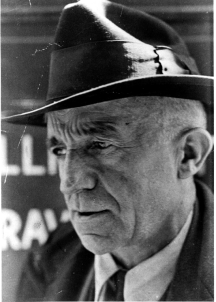catholic worker movement
The Catholic Worker Movement began simply enough on May 1, 1933, when a journalist named Dorothy Day and a philosopher named Peter Maurin teamed up to publish and distribute a newspaper called "The Catholic Worker." This radical paper promoted the biblical promise of justice and mercy.
Grounded in a firm belief in the God-given dignity of every human person, their movement was committed to nonviolence, voluntary poverty, and the Works of Mercy as a way of life. It wasn't long before Dorothy and Peter were putting their beliefs into action, opening a "house of hospitality" where the homeless, the hungry, and the forsaken would always be welcome.
Over many decades the movement has protested injustice, war, and violence of all forms. Today there are some 228 Catholic Worker communities in the United States and in countries around the world.
from catholicworker.org
“We were just sitting there talking when Peter Maurin came in.”
“We were just sitting there talking when lines of people began to form saying, “We need bread.” We could not say, “Go, be thou filled.” If there were six small loaves and a few fishes, we had to divide them. There was always bread.”
“We were just sitting there talking and people moved in on us. Let those that can take it, take it. Some moved out and that made room for more. And somehow the walls expanded.”
“We were just sitting there talking when someone said, “Let’s all go live on a farm.”
“It was as casual as all that, I often think. It just came about. It just happened.”
“I found myself, a barren woman, the joyful mother of children. It is not easy always to be joyful, to keep in mind the duty of delight.”
“The most significant thing about The Catholic Worker is poverty, some say. The most significant thing is community, others say. We are not alone anymore.”
“But the final word is love. At times it has been, in the words of Father Zossima, a harsh and dreadful thing, and our very faith in love has been tried through fire."
“We cannot love God unless we love each other, and to love we must know each other. We know Him in the breaking of the bread, and we know each other in the breaking of the bread, and we are not alone anymore. Heaven is a banquet and life is a banquet, too, even with a crust, where there is companionship."
“We have all known the long loneliness and we have learned that the only solution is love and that love comes with community."
“It all happened while we sat there talking, and it is still going on.”
– Servant of God, Dorothy Day
The Long Loneliness (Postscript)



